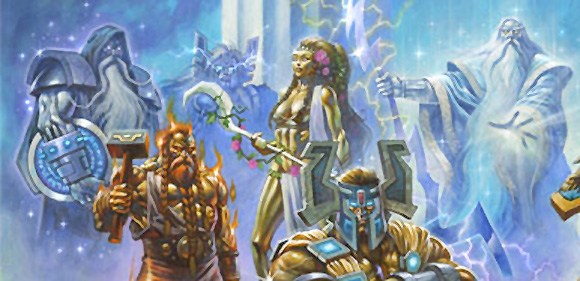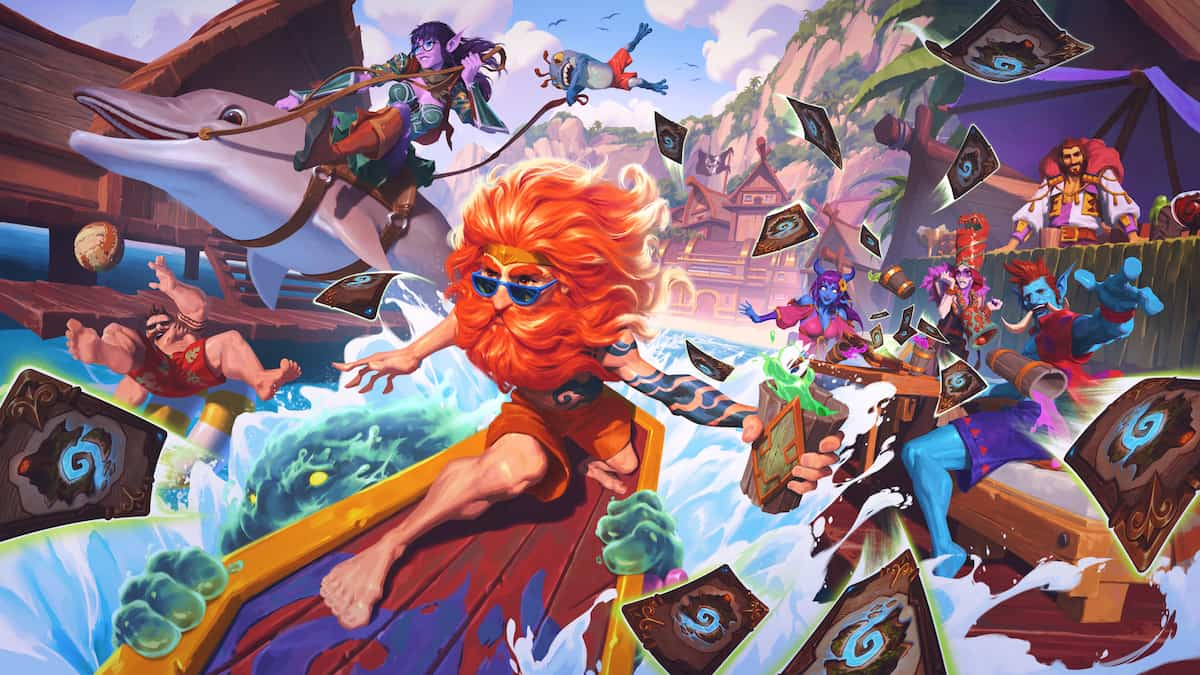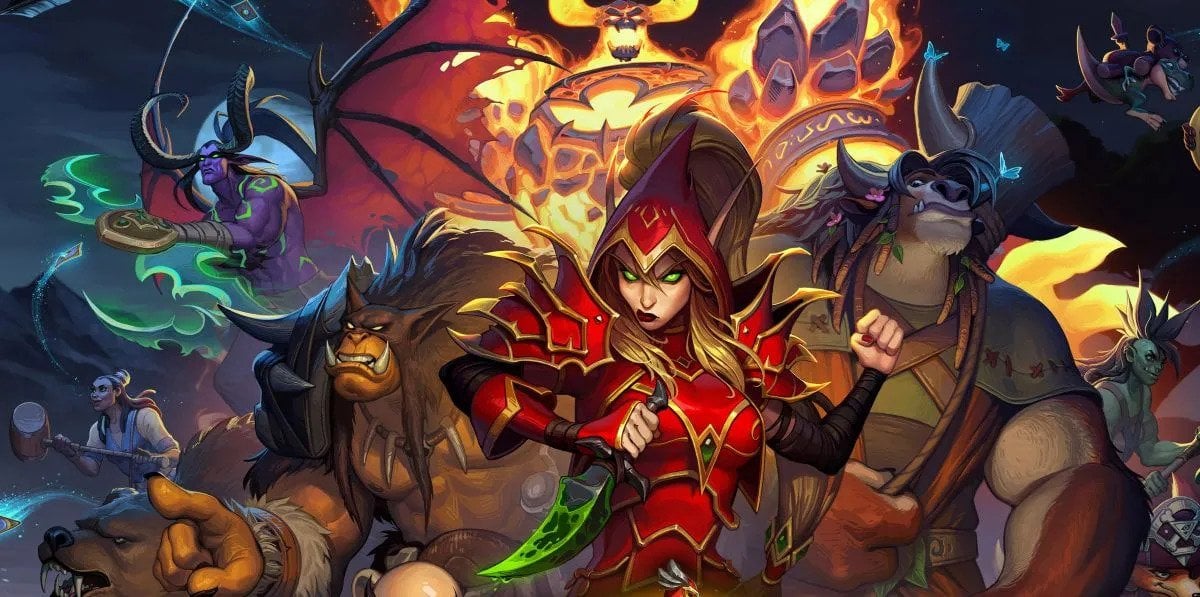Hello and welcome to yet another Flavor Text and Lore article. Stay a while… And read about the story and lore behind the dreaded Old Gods and their whispers!
The newest Hearthstone expansion is nearly upon us, and this time it focuses on a very unexplored facet of World of Warcraft’s mythology: the Old Gods.
Unlike the powerful and blatantly obvious threat posed by the Dark Titan Sargeras and his Burning Legion, these Lovecraftian horrors are shadowy figures that work in the background, corrupting and influencing the denizens of Azeroth (and sometimes, beyond) to do their bidding. They whisper in the minds of those that come to close, slowly driving them to destructive ambition or outright madness, always with a slant toward fulfilling their ultimate purposes.
While Blizzard’s storytellers have denied it, it is speculated that the Old Gods may indeed be the ultimate threat to be faced by the heroes of Warcraft, a much more insidious force than the mighty Legion. The Legion, powerful as it may be, is commanded by Sargeras, a single Titan, while the Old Gods are at least four, and each one has powerful as a Titan in its own right.
In fact, it seems that Blizzard is still actively shaping, or at least keeping secret, the full extent of the Old Gods’ purpose in the storyline. As such, some of what you will read in this article is me piecing together loose strands of information, and some speculation. I will point out those cases. So, without further ado, let’s begin!

The Darkness Before Time
The prevalent creating mythos in Azeroth goes something like this: in the beginning, the world was a whirlpool of chaotic elements. The arrived the space-faring, god-like creatures known as the Titans. The leaders among them, dubbed “The Pantheon”, terraformed the planet and left behind beings made of metal and stone, whose mission was to maintain Azeroth habitable and prepare it for the development of organic life.
Yet during the Titan’s absence, before life could sprout on Azeroth, something else arrived. The Old Gods came, and nobody’s exactly sure from where they came, though in a certain World of Warcraft dungeon, a servant of theirs says “We span the universe, as countless as the stars.” so we can assume that the Old Gods also had space-faring capabilities of some kind.

In any case, these powerful beings set foot (tentacle?) upon young Azeroth and immediately brought it back to a state of elemental chaos, unleashing the elemental planes of fire, water, wind and earth and empowering the elemental lords – ragnaros-the-firelord, neptulon the Tidehunter, alakir-the-windlord and Therazane the Stonemother – to act as their lieutenants.
They then created beings in their own image to serve them, the most widespread of them the insectoid Qiraji and Mantid, who built large metropolises across Azeroth. Finally, they perverted the Titans’ servants using the Curse of Flesh.

The Curse of the Flesh and the Old God’s End
The Curse of the Flesh turned the Titans’ stone and metal creations into living beings, facilitating the assimilation of Azeroth by the Old Gods. As such, the Earthen became the Dwarves, and the Mechagnomes became the Gnomes.

If you’ve participated in the “Unite Against Mechazod” Tavern Brawl, you know that he starts the fight by emoting “I will cleanse you both of the Curse of Flesh!”. He is in fact referring to the Old God’s curse, which had the side-effect of ending up creating some of the organic races that inhabit Azeroth to this day, from the Titans’ constructs.
When the Titans discovered this, they travelled back to Azeroth and started what is assumed to have been the most devastating war ever raged on the planet, a war that reshaped the very foundations of the land. At least one Old God is rumoured to have perished, as well as a Titan – whose blood, according to the legends, pooled and became the Well of Eternity, the sea-sized lake from where all magic originated. This fact alone, if indeed true, shows just how god-like, massive and powerful the Titans and their opponents were.
In the end, the Titanic Pantheon succeeded in laying waste to the Qiraji and Mantid empires, banishing the elemental lords to the elemental plane, and sealing away the Old Gods in the depths of the world. They could not outright destroy them, however – the Curse of Flesh was too widespread across Azeroth, having entered in a symbiotic relationship with the young world, and killing the Old Gods would have rendered the world forever incapable of birthing life.

The only races that are confirmed as having originated from the Old Gods’ meddling with the Titans’ servants are the Dwarves and the Gnomes, though it is speculated that, many millennia after the Old Gods’ banishment, a long-dormant strain of the curse affected the originally organic half-giant race of the Vrykul, and the infected gave birth to the first humans.
The Dawn of the Dragonflights
So the Titans created ever more powerful servants, to watch over the resting places of the Old Gods – the metallic Watchers, an example of which is Ironaya, represented in the Hearthstone card art for keeper-of-uldaman. Aeons after the departure of their masters, the Watchers decided to empower one of the most promising budding races (at the time) with their powers, passing onto them the mantle of defending the world.
Their chosen race was that of the Dragons, and the chosen among them to bear the mantle of chief protectors of Azeroth were the most talented, emotionally and intellectually developed of the budding race, the five young proto-drakes that became know as “The Aspects”: ysera of the Green Dragonflight as mistress of dreams and the wilds, alexstrasza of the Red Dragonflight as the guardian of all living things, nozdormu of the Bronze Dragonflight as the custodian of time, malygos of the Blue Dragonflight as the master of magic, and finally Neltharion of the Black Dragonflight – would would later go mad and take on his new name, deathwing – as the warden of earth. They were from then on known as “The Aspects”.

It is unclear why the Watchers passed their vigil onto the Dragons. The most common and widely accepted speculation is that as the millennia passed, the mechanical Watchers started shutting down or even malfunctioning, something that seems quite plausible when one attests that, in the present time, most watchers encountered by the players in World of Warcraft are immediately hostile and seem to view the living races as a plague, much like Gearmaster Mechazod does in Hearthstone.
It is also possible that the Old Gods themselves played a part in the decline of the Watchers. Upon defeating the Watcher Myzrael in one of the early areas of World of Warcraft, players see her banished to the elemental plane of the earth, Deepholm. If they travel to Deepholm later in their adventures, they can find her again, no longer hostile, and she thanks them for having rid her of “the tainting influence of the ancient gods”.
Regardless of the origins of their decline, it can be speculated that the wisest among the Watchers predicted this and decided to pass on their duty to the organic races before Azeroth was compromised once more.

The Whispers of the Old Gods
As they are forever linked to the very fabric of Azeroth, even from their prison, and with great effort, the Old Gods can exert influence over the realms. The most common manifestation of their power are the whispers that unfortunate, doomed individuals will at some point hear.
These whispers will drive them to commit acts of great malice in service to the hidden masters, while the victim is usually under the belief that he or she is acting of her own free will and, in fact, upon an idea that he or she had on their own. In this way, the Old Gods have subverted hundreds if not thousands of beings to do their bidding and even worship them – usually as part of cult known as the Twilight Hammer.

The Naga are also servants of the Old Gods, dating back from the shattering of the world that ended the War of the Ancients. Queen Azshara, utterly defeated by the efforts of the Druid Hero Malfurion and his brother illidan-stormrage, found herself and her Highborne cohorts trapped in a crumbling castle quickly sinking into the sea – at which point a pact was whispered into her mind, and promptly accepted, transforming her and her night elf brethren into the serpentine Naga.
No race is immune to the whispering, and inevitably, exposure to the voices of the elder ones leads to total and complete madness. In this matter, the Old Gods wage a silent, hidden war against the shackles that bind them, and have done so since nearly the dawn of time.
Thus, they shaped much of Azeroth’s darkest history and tragedy. They had a subtle but essential hand in the Legion’s original invasion of Azeroth (the War of the Ancients is beyond the scope of this article, but I wrote about it at length in the Druid’s Flavor Text and Lore article) and it is believed that if Sargeras had indeed succeeded in his invasion, the Old Gods would be able to burst out from their confinement and end him, taking control of his mighty armies.

They did orchestrate this by whispering to their nemesis, the noble black dragon Neltharion, slowly convincing him that the young races were recklessly dabbling in magic; that they were a danger to Azeroth; that only the Dragons had the wisdom to rule this world; and that him, as the most powerful among them, was the only one to rule the dragons.
They made him believe that a great evil was coming, and that the only way to prevail over it would be to create a great, powerful artifact, and infuse it with the power of all the combined dragonflights – and so he did.
He created the Dragon Soul – believing it to be infused with his own power, while in reality the small golden disc was steeped in all the dark energy the Old Gods could muster from within their prisons – and convinced the other aspects to commit a considerable part of their power, and that of their dragonflights, to empower the artifact even further.

When the other Aspects discovered that they had been tricked, it was too late. The Dragon Soul – thereafter dubbed “Demon Soul” – had considerably weakened the Dragonflights, and when malygos confronted Neltharion, the black Dragon mercilessly wiped his whole dragonflight in a single magical burst, driving his former friend to madness.
Neltharion, too, bursting by the seams with the artifact’s power, finally went mad and became the horror known as deathwing, forever doomed to unwittingly do the Old Gods’ bidding while believing that he is conquering Azeroth as his own, perfect, empire.
While deathwing was eventually tricked into losing the Demon Soul and the artifact was used to prevent the Legion’s invasion and then sealed away, the damage was done: one of the world’s protectors was turned against it, another was reduced to madness, a whole dragonflight had been decimated and the others began a slow decline towards extinction. Through their whispers, the Old Gods had dealt a crippling blow to Azeroth’s first line of defense against their evil.
This is but the first, and perhaps greatest, of the victories the Old Gods achieved toward their liberation. Over the next few millennia, they hatched many plots, some big, others small, but all adding towards their ultimate goal of resurfacing once more and reshaping Azeroth to their image. Indeed, just like the first invasion of the Legion, much of Azeroth’s plights can be traced back to a few, choice whispers…

C’thun, the Original Old God
While the existence of the Old Gods was hinted at way back in the early Warcraft manuals, it was only late into the classic World of Warcraft’s lifecycle that Blizzard started developing the related lore.
This was when the first Elder God was named: C’Thun (a reference to H.P. Lovecrafts’ Cthulhu ), a massively powerful being sleeping beneath the sands of the desert of Silithus, at the very south-western edge of Kalimdor.
The players had always been able to travel to Silithus – in fact, traveling there was mandatory for acquiring the items required to challenge ragnaros-the-firelord in World of Warcraft’s original raid instance – but it had mostly been an area bereft of the rich quest-lines that could be encountered in other zones.

This all changed by the time Blizzard announced the second-to-last raid instance, where the players were challenged to invade the ruins of the old city of Ahn’qiraj and breach the Temple within, striking at the heart of the Old God himself before he could complete his reawakening and plunge Azeroth into darkness.
But the road to that challenge was arguably more memorable than the challenge itself. For the gates to the city were sealed and could only be opened upon completing a long event. This was called “The Gates of Ahn’Qiraj”, and never an event of such scale was again attempted in World of Warcraft.
How big was it? Well, on each World of Warcraft server, it required weeks or even months of hundreds of players from each faction working thoughter, pooling resources and accomplishing challenges so that one player – only one per server – could assemble the Staff of the Shifting Sands.
That’s right, only the leader of the first guild in each server to assemble the staff would have the honor of opening the gates, setting in motion a one-time large scale battle that would end up with the doors to the city and temple being forever opened on that server, and earning the coveted title of “The Scarab Lord”.
Only a handful of the original Scarab Lords remain as active players after ten years have passed, and to meet one in person is truly a real-life achievement.
Once the gates were open, the players could storm the dungeons at any time, and many guilds broke on the challenge presented to them by the combined might of the Old God’s servants. But it was C’thun himself, at the very bottom of the temple, that proved insurmountable. In fact, it is remembered by many as World of Warcraft most challenging boss, only having been beaten after Blizzard patched the game specifically to make him weaker.
So, was that all? For all the power of the Old Gods, how would a mere group of mortals be able to kill one?
Well, it is debatable whether mortals can ever actually kill an Old God. The players never got to see more than a part of C’Thun, and after that part lay defeated, his influence could still be felt – notoriously, years later, in a story told in the World of Warcraft comic, his whispers drove the Twilight Hammer to seek the power of the successor to Medivh in order to revive the Old God one more.
So it would seem that either C’Thun was only partially defeated, or than even death does not mean the end of an Old God.

Yogg-Saron, The Beast With a Thousand Maws
Far within the northern reaches of Northrend, even farther north than the fortress of the Lich King himself, sits the gigantic Titan complex of Ulduar, under which Yogg-Saron is imprisoned.
Unlike C’Thun, Yogg-Saron did not create an army of insectoid servants. Although he is attended to and his will is carried by tentacled beasts known as “Faceless Ones”, Yogg-Saron is a master of corruption, and his whispers have perverted several of Northrend’s oldest inhabitants to serve him, from the few spider-like Nerubians that managed to escape the Lich’s King conquest, to the primal, half-giant Vrykul, and even his former Watcher incarcerators.
They players are led to face Yogg-Saron due to the warnings of brann-bronzebeard, who had spent most of the Northrend campaign exploring the old Titanic ruins and stumbled across evidence of the Old God’s existence and imminent release.
As they dive deep into the dungeon, they uncover evidence that once more ties the Old God to some of the most disastrous events to happen to Azeroth.
One such event is the aforementioned maddening of Neltharion and his transformation into deathwing, but it is also revealed that Yogg-Saron was responsible for manipulating the half-orc Garona Halforcen (who during the First War had worked as a double-agent for the Alliance) into killing varian-wrynn’s father, King Llane Wrynn, effectively sealing the Alliance’s defeat in the First War.

Finally, there is some connection between Yogg-Saron and the Lich King himself. It is never made explicit what, so here we must again fall into the realm of speculation. It should be noted, then, that while Prince Arthas had made controversial choices while fighting the scourge in his homeland, it was only upon setting foot in Northrend that he turned completely to evil, a path that was sealed once be took possession of the runeblade Frostmourne, but upon which he had been threading since arriving to the frozen shores. One cannot help but speculate that his corrupting may have been orchestrated by the Old God.
Once again, the players can “kill” the Old God, but he never fully emerges from his prison. And later, practicers of archeology can find an exquisite piece, an ancient Nerubian puzzle box. The puzzle can never be truly solved, but with each attempt, the supposedly dead Yogg-Saron whispers in one’s ear…
N’Zoth, the Unknowable One
There is little to go by when talking about N’Zoth. His name was mentioned briefly in the Cataclysm expansion, where he was referred to as facilitation deathwing’s plans, but nothing else was discovered.
Current speculation based around one of the whispers from Yogg-Saron’s puzzle box, “In the sleeping city of Ny’alotha walk only mad things.” leads us to believe that the Old God may actually either reside inside the Emerald Dream ( hence “sleeping city”) or at the very least is the true power behind the Dream’s crippling corruption, the Emerald Nightmare.
As players will finally venture into the Dream in the next World of Warcraft expansion, perhaps more will be made known about N’Zoth.

Y’Shaarj, the Scourge of Pandaria
It is quite certain that Y’Shaarj was one of the Old Gods that was actually killed during the war with the Titans. But from here on the lore offers two different paths.
Some references point to Y’Shaarj cursing the land of Pandaria with his dying breath, infesting it with shadows of his former self.
Other claim that the Titans, unable to destroy the mortal remains of the Old God, sealed it deep within Pandaria, hoping the land would be able to contain the corruption emanating from within.
Regardless, the God’s lingering presence was forever felt in the history of Pandaria: dark emotions like fear, anger or hatred would physically manifest and sometimes possess their hosts, and as such the Pandaren developed a culture of tranquility and strove to master their emotions.

The arrival of the war between the Horde and the Alliance to their peaceful shores brought with it an upheaval of emotions, and as such, the power of the Old God was made physically manifest in the form of the hulking, dark abominations called the Sha, towering giants that would roam the land, corrupting everything in their path.
But the true horror came when the Warrior Hero Garrosh Hellscream managed to recover the Heart of Y’Shaarj. The warlord unleashed its power at the very heart of Pandaria, devastating the beautiful area forever, and acquiring immense power – power that he used to remake the Horde in his image.

You can read the full tale of his despotism, and the rebellion that ended it, in the Warrior Flavor Text and Lore article. Here, it suffices to say that the combined forces of the rest of the Horde and the Alliance eventually defeated him, and with his defeat the remainder of Y’Shaarj seemed to dissipate.
Garrosh had always been an aggressive, warlike character. But he was also honorable and opposed indiscriminate killing and wanton destruction. He became seemingly more corrupt after his Northrend campaign, and seemed to go over the edge after landing in Pandaria. Was he another victim of the whispers? We may never know.

Conclusion
The Old Gods have been waging a war from the shadows since their defeat at the dawn of time, and their intent is to take Azeroth for themselves, either destroying or enslaving its inhabitants.
But for all the rich history and lore available to Warcraft players and scholars, these powerful entities have been hidden behind a veil of mystery, and only the lore wardens at Blizzard know the full story – if it is even fully written.
Maybe the Hearthstone expansion will help shed some more light on the plans and current situation of these ancient beings.
In the meantime, let us know in the comments if you enjoied the article, and if you are looking forward to the new expansion!





Published: Mar 23, 2016 09:52 am